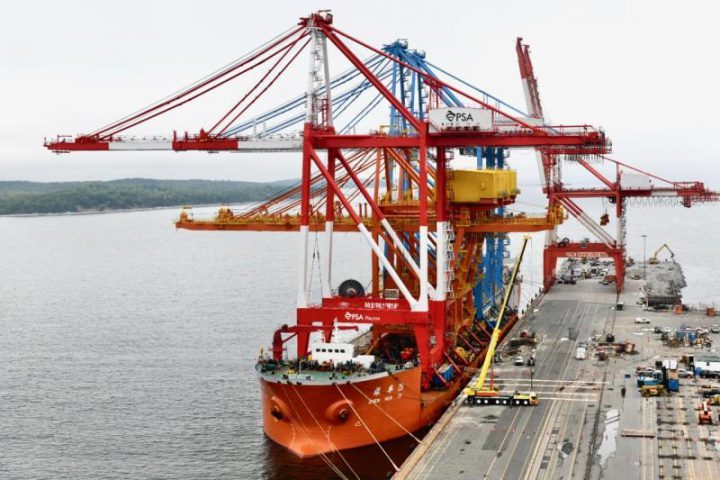When the board of the Halifax Port Authority (HPA) chose Captain Allan Gray as its new president and CEO in November 2019, his first goal was to collaborate in the community.
The Port of Halifax is a multi-faceted port processing over 540,000 TEU (2019) in container cargo, with strong transport links to Central Canadian and US Midwest supply chain hubs.
Providing $2 billion in economic output with the Port of Halifax’s operations and Nova Scotia exporters, the northeastern Port is ideally sized for its most innovative expansion effort yet.
“When I got to Halifax, my key platform was collaborative decision-making,” Gray told PTI. “We need to talk, we need to collaborate and get better ideas.”
Decision-makers at the port wanted to bring in new ideas to solve problems at its facility, ranging from standardising banks of data to optimising port call processes.
In order to achieve its goals the port will introduce a living lab for Port Innovation, Engagement & Research (PIER) in 2021.
The PIER, first announced in January 2021, will be based out of Pavilion 20 in the historic Halifax Seaport District. Starting in mid-March, theport will begin the transition of Pavilion 20 and the construction of a physical collaborative space where partners are brought together to utilise the port’s expertise and facilities on problem-solving in a real-life environment.
“The living lab concept is deliberately bringing stakeholders together,” Gray said. “Halifax is an abundant ecosystem in ocean innovation. It’s just thriving with young companies, starting up with new ideas.”
The founding partners announced for The PIER include CN, a leading North American transportation and logistics company; PSA Halifax; OMC International; and the Halifax Port Authority itself. Gray revealed to PTI that Saab has also signed up as a founding partner for the living lab.
“We’re going to solve real-life problems, and we’re going to get the ecosystem to work with us to solve those problems,” he said.
SMEs and start-up companies in Halifax will be invited to draw experience, resources, and expertise from logistics and shipping giants like PSA and CN – as well as the physical and digital infrastructure. “Let’s tap into this, and give stakeholders access to those companies – but also give them access to us. And that’s the real selling point in the living lab.”
Transparency in the supply chain
The most critical challenge facing the Port of Halifax and its stakeholders is transparency and resiliency in the supply chain, said Gray.
“I think [in the past] the port had been criticised for perhaps not being as transparent in its behaviour,” he said.
Though of course not a deliberate intention of the port, Gray said, in its response the living lab will seek to open up its port processes and highlight the changing impacts of the supply chain as clear as possible when cargo is flowing through the port.
Outside of The PIER initiative there are a number of other projects ongoing at the Port. This includes the partnering of Saab and Halfax-based BlueNode, which the Port says is emblematic of the spirit of collaboration the port will hope to foster with The PIER.
BlueNode and Saab will collaborate with stakeholders using the port every single day – including the likes of PSA International – to standardise, organise and dissipate key banks of manifest data from port users.
“There’s an inherent problem across the world with the quality of data – and how people input data differently,” Gray said.
“People talk about port call optimisations and how we reduce global emissions, for example. We need a transparent supply chain to know what every sector in the supply chain is doing to be able to improve that.”
The data sets can range from the impact of day-to-day emissions, noise levels, and underwater noise; as well as the footprint of vessels, port equipment, and rail and truck vehicles entering the port.
In addition, the Port and its stakeholders are working to develop a collaborative decision-making platform. Every decision, movement, and investment will be scored against the UN’s Sustainability Goals, ensuring that not just port actors but the local port community can benefit from knowing about the environmental and social impact of port operations.
Ultimately, this standardised information will inform every fiscal and social initiative from the port: “If you’re going to spend $300 million with taxpayers’ money (for example) on infrastructure somewhere, let’s make sure that that infrastructure spend not only gives you the economic lift for it, but also the environmental offset, and the social offset of that decision,” he said
“We’ll be able to visualize the answer to that on a platform where we can say here is the visual output of that decision.
True and tangible benefits for Halifax
With all of the grandeur and excitement that The PIER brought when it was announced in January 2021, it is easy to be washed away in the fervour of the potential that this collaborative living lab can bring to the community.
Despite the physical lab space currently under construction, there is still huge opportunity for success in the first year, most notably showing to the community that the Port is serious on joining forces.
“In the short term, if we can demonstrate to the community that we’re serious about investing in the community and solving problems collaboratively with that community: that would be our first win,” he said.
And industry take-up will be another key indicator, noted Gray. “We’re already getting good momentum of partners and members wanting to join – but if we see a lot of activity in the port in year two, that would be a demonstration that we’ve hit the nail on the, on the head.”
Whether that be the newly-partnered Saab providing its wealth of expertise to start-ups like BlueNode in demystifying data, or industry titan PSA International collaborating with SMEs on improving port call optimisation, a confluence of stakeholders is the ultimate goal for the Port of Halifax and the community it serves.
Written by Jack Donnelly



